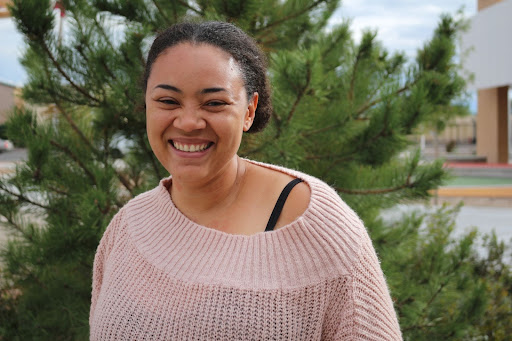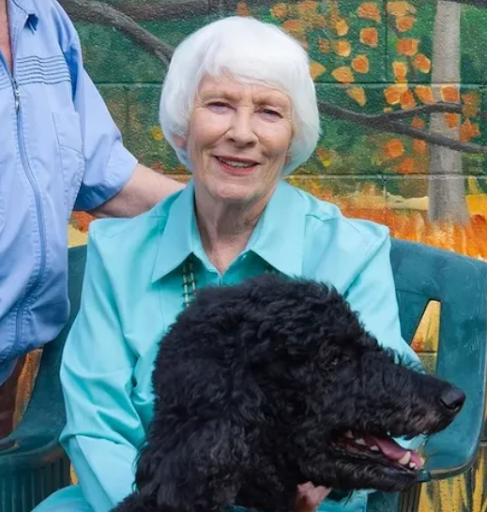By: Junko Featherston and Andres Torres
On a rainy day in downtown Albuquerque, Mariah Baca was leaning against a stuccoed fence of a gated community. Her shopping cart was filled with scratched bins containing clothes, pillows, used toiletries, and a bright yellow tarp.
The air was cold and as we approached, she had a look of sadness.
Mariah has been homeless for more than two years. While opening up about her homeless experience, she said that her addiction to heroin keeps her on the streets.
“Wake up, do heroin, be high, kill myself, that’s my life,” Baca said. “I am just sick of it, you know? I want to escape it, but I can’t afford no help.”
Baca is one of the many unhoused New Mexicans living on the streets of Albuquerque.
According to the New Mexico Coalition to End Homelessness (NMCEH), more than 1,300 people are homeless in New Mexico.
The NMCEH’s annual Point-in-Time Count shows that nearly half of the city’s unhoused population suffers from substance abuse and mental health issues.

Homeless Safe Outdoor Spaces
Safe outdoor spaces are designed to provide dedicated spaces for tents, recreational vehicles or light vehicles for temporary occupation.
The state has seen a rise in non-profit organizations submitting applications for Safe Outdoor Spaces.
As it sits, three spaces were approved, one is under review, two got denied, and three are awaiting review.
The reason for these spaces is so that the city can solve its’ biggest issues when discussing the homeless crisis: drug addiction and mental health instability.
District 19, the international district, is the place of residency for many unhoused New Mexicans. In the Zuni and Central area, people are found on the streets in large numbers.
With winter here, resources for the homeless are uncertain. According to the city, the only plan is safe outdoor spaces, which do not add any overhead coverage.
Among the many other issues the homeless face, the average cost of rehab in the U.S. is between $5,000 – $20,000 for an inpatient treatment that lasts 30 days.
On Oct. 3rd city council met and secured $750,000 for Safe Outdoor Spaces in Albuquerque. They thought this is a small step forward and added that more resources are needed for the homeless community, which is the only way to stop the cycle of homelessness.
Democrat Janelle Anyanonu
We met up with District-19 D. Candidate Janelle Anyanonu at the International District Library on Central. We spoke about what she aims to do to help with the fight for support centers for the unhoused population.

Anyanonu mentioned that since the Richardson administration, most state-funded programs that addressed addiction prevention were thrown out and never replaced.
Former Gov. Suzanna Martinez brought some of these programs but Anyanonu thinks we need more.
When discussing what happened to those programs and how we can reestablish them in our state, Anyanonu says a small number of programs have come back since Michelle Lujan Grisham has been in office. But she says it is not nearly at the level we need.
One of the biggest concerns that Anyanonu has for the city in regard to the homeless crisis, is that there will not be enough funding or resources for the homeless.
She mentioned that there needs to be more long-term solutions but acknowledged that Safe Outdoor Spaces are a small step in the right direction.
“My biggest fear is that once these Safe Outdoor Spaces happen, the rest of the population is swept under the rug and forgotten about. With that currently being one of the only solutions, it could ultimately fail,” Anyanonu said.
“I intend to advocate and push for more long-term solutions for the homeless community while keeping pressure, on the municipal level, to address the short-term solutions so people are not forgotten,” Anyanonu said.
Another issue Anyanonu has with Safe Outdoor Spaces is that they do not offer any infrastructure or safeguard against the weather.
Anyanonu says that winter around the corner if the most developed Safe Outdoor Space has no infrastructure to guard against the winter weather, it can lead to some real tragedies.
Anyanonu also mentioned that citizens in district-19 have internalized stereotypes about the homeless community.
Many think all homeless are committing crimes, but Anyanonu does not directly relate crime to homelessness.
She knows crime is an issue in her district but believes crime is a ripple effect from being homeless and believes we need to reduce our homeless population to reduce crime.
One of the biggest concerns Anyanonu has for District-19 is that these Safe Outdoor Spaces will pop up and people will think it’s a solved problem when the rest of the community is left out.
Anyanonu mentioned that she would rather see the homeless be helped than locked up.
Republican Kathleen Jackson
Kathleen Jackson, R. Candidate for D-19 has firm stances on homelessness and what needs to be done.
After reaching out to Jackson on her website, kathleen4district19.com, through a chat room where she answers questions.
After mentioning we were reporters for New Mexico News Port, we asked this question, “What does Kathleen think about homelessness” the answers provided are from that response.

Jackson’s stance on homelessness refers to us needing to take care of the veterans as the main priority.
She also included that drug users on the street should not go on without criminal penalties if they refuse rehab.
“As I go around our district parks, I am meeting many healthy young men and women in their 20s and 30s doing drugs and hanging out,” Jackson said.
“We need to use tough love on them and say no more free tents, phones and EBT cards – get a job and contribute something to society.”
Both candidates agreed that more mental health facilities for the homeless should be available.
They also both mentioned that the city’s current resources could be better coordinated.

NMCEH Alexandra Paisano
Alexandra Paisano, coordination entry systems director at the New Mexico Coalition to End Homelessness (NMCEH), mentioned how she thinks that homeless individuals are the ones that should be suggesting resources for their community instead of city officials.
According to Paisano, NMCEH are big supporters of Safe Outdoor Spaces.
She also said that in district 19, Zuni and Central have always been a “hot spot” for homelessness and the best way to end the cycle of homelessness is to broaden the spectrum of resources available.
When asking Alexandra about what she thinks about the funding for Safe Outdoor Spaces and how they will use that money, she says that she hopes workers will be properly paid.
“Without proper compensation, no one will want to do the job and the cycle will continue.” Says Paisano.
In response to winter resources Paisano said that in order to find out what the homeless need, we need to talk with actual people that are homeless.
According to Paisano, without consulting them, we cannot assume what the homeless community needs in the winter.
Albuquerque’s Gateway Center
The City’s newest homeless resource, The Gateway Center, was acquired for $15 million.
The facility got delayed multiple times, but the City said that part of the building would open sometime during winter, but phase one will open in summer 2023.
Once phase one is complete, the center will reportedly be able to serve 50 single, women-identifying individuals a night and 1,500 medical/addiction transports a year.
The City said they planned and built this resource to provide medical, behavioral health, addiction recovery, and job training services.
As the city pushes to fund homeless resources, people like Mariah Baca will have to wait until Safe Outdoor Spaces establish more infrastructure and workers.
Until then the city’s only plan is to create safe outdoor spaces all over Albuquerque.